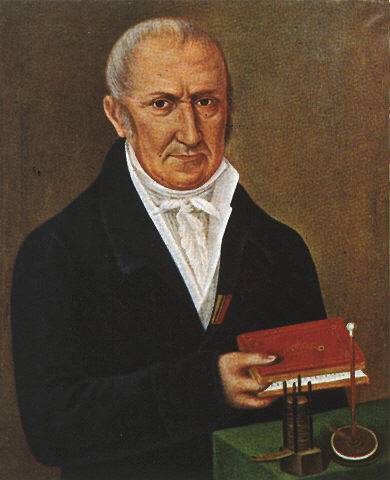
FAQ About Alessandro Volta

Who was Alessandro Volta?
Alessandro Volta was an Italian physicist credited with inventing the voltaic pile, the first chemical battery capable of producing a steady electric current. This invention laid the foundational work for electrical science and technology. Volta was born on February 18, 1745, in Como, Italy, and became a professor of physics at the University of Pavia. His pioneering work significantly advanced the field of electrochemistry.

What is the voltaic pile?
The voltaic pile, invented by Alessandro Volta in 1800, is considered the first true battery. It consists of alternating discs of zinc and copper, separated by pieces of cardboard or cloth soaked in saltwater. This arrangement creates a chemical reaction that produces an electric current. The voltaic pile marked a significant milestone in the development of electrical devices and systems.

How did the voltaic pile contribute to science?
The invention of the voltaic pile was a groundbreaking contribution because it provided scientists with a reliable source of continuous electrical current. This enabled further exploration and experimentation in electromagnetism and electrochemistry. It also paved the way for the development of more advanced batteries and electrical devices, ultimately catalyzing advancements in modern technology and industry.

What were some of Alessandro Volta's other contributions to science?
In addition to inventing the voltaic pile, Alessandro Volta is known for his work on the electrophorus, an early device used to generate static electricity. He also discovered and isolated methane gas in 1776. Volta's scientific pursuits helped establish foundational principles in electrochemistry and power generation.

When did Alessandro Volta invent the voltaic pile?
Alessandro Volta invented the voltaic pile in 1800. This invention was announced in a series of letters to the Royal Society in London, where Volta detailed his innovations in generating continuous electrical current.

Why is Alessandro Volta considered a pioneer in electricity?
Alessandro Volta is considered a pioneer in electricity primarily due to his invention of the voltaic pile, which was the first device able to produce a steady and continuous flow of electric current. Before this, there was no sustained way to produce electricity, which significantly limited scientific exploration. Volta’s innovations laid the groundwork for future electrical power generation and paved the way for modern batteries.

How did Alessandro Volta's discovery impact modern technology?
Volta's discovery of the voltaic pile impacted modern technology by providing a means to harness and use electrical energy in a controlled manner. This discovery directly influenced the development of electrical circuits, batteries, telegraphs, and numerous other electrical devices that form the backbone of modern technology.

What is the significance of methane gas in Volta's research?
Alessandro Volta's discovery and isolation of methane gas in 1776 were significant because it expanded the scientific understanding of gases and combustion. Methane is now recognized as a major component of natural gas, and Volta's early work laid the groundwork for its later applications in energy production and chemistry.

Did Alessandro Volta receive any awards or honors for his work?
Yes, Alessandro Volta received numerous accolades for his contributions to science. In 1801, he was invited by Napoleon Bonaparte to demonstrate his discoveries in Paris, where he was awarded a gold medal. Later, the unit of electric potential, the volt, was named in his honor to recognize his contributions to the field of electricity.

Where did Alessandro Volta study and teach?
Alessandro Volta studied at the Jesuit school in his hometown of Como, Italy. He later became a professor of physics at the University of Pavia, where he conducted much of his groundbreaking research in electricity and electrochemistry. Volta taught and inspired many students during his tenure there.

What was the reaction of the scientific community to the voltaic pile?
The scientific community reacted with great enthusiasm to the invention of the voltaic pile. It was seen as a revolutionary tool for scientific experimentation, opening up new avenues for research in electricity. Notable scientists like Michael Faraday and Humphry Davy used voltaic piles in their experiments, which led to further discoveries in electromagnetism and chemistry.

What motivated Alessandro Volta to invent the voltaic pile?
Alessandro Volta was motivated to invent the voltaic pile by his curiosity and desire to understand electrical phenomena. He sought to counter the claims of Luigi Galvani, who believed that electricity was generated in animal tissue (which he termed "animal electricity"). Volta demonstrated that electricity could be generated chemically without any biological material, thereby establishing a new foundation for the study of electricity.

How did Alessandro Volta's work influence other scientists?
Alessandro Volta’s work inspired and influenced many scientists, including Michael Faraday and Humphry Davy, who utilized the voltaic pile in their research. Volta's innovations set the stage for later developments in electromagnetism and electrochemistry, providing essential tools and insights that furthered scientific understanding in these fields.

What was a key challenge Volta overcame in his research?
A key challenge Alessandro Volta faced was in demonstrating the reliability of chemical processes in generating electricity, as opposed to the prevailing belief in "animal electricity." By successfully creating the voltaic pile, he was able to provide concrete evidence of chemical electricity generation, which helped to refine contemporary understanding and correct misconceptions about electricity's origins.

Are there any places named after Alessandro Volta?
Several places and institutions are named after Alessandro Volta in honor of his contributions to science. For example, the Volta Temple (Tempio Voltiano) in Como, Italy, is a museum dedicated to his life and work. Additionally, the SI unit of electric potential, the volt, is named in his honor.

What was the relationship between Alessandro Volta and Luigi Galvani?
The relationship between Alessandro Volta and Luigi Galvani was one of respectful scientific debate. Galvani's discovery of what he thought was "animal electricity" in frog legs prompted Volta to conduct experiments that led to the invention of the voltaic pile. Volta’s work ultimately proved that electricity could be generated chemically, rather than relying solely on biological processes, which helped clarify and expand scientific understanding.

How does the discovery of the battery relate to modern applications?
The discovery of the battery, starting with the voltaic pile, underpins countless modern applications. Batteries are now integral to everyday life; they power cell phones, laptops, cameras, and countless other devices. The basic chemical principles that Volta uncovered are still used in the modern design and development of more advanced and efficient batteries today.

How are Alessandro Volta's contributions recognized today?
Today, Alessandro Volta's contributions are recognized in various ways. The term "volt," the unit of electric potential, commemorates his name. Educational institutions, research awards, and exhibitions are dedicated to his memory and work. Additionally, the legacy of his research continues to influence both academic studies and practical applications in technology and industry.

Did Volta have any notable students or proteges?
Although specific notable students or proteges of Alessandro Volta are not widely documented, his position as a professor at the University of Pavia allowed him to influence and educate a generation of students. These students would've been exposed to his pioneering ideas and innovations, which would have significantly influenced the scientific community of the time.

How did Alessandro Volta’s invention change the understanding of electricity?
Alessandro Volta's invention of the voltaic pile significantly changed the understanding of electricity by demonstrating that it could be generated through chemical reactions rather than being solely a phenomenon of living organisms or atmospheric effects. This moved the study of electricity into a new scientific realm focused on chemistry and physics, laying the groundwork for modern electrical engineering.
